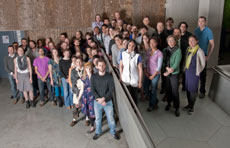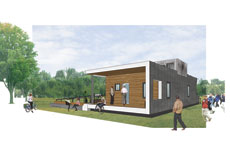Solar Decathlon 2011
Parsons The New School for Design and Stevens Institute of Technology
Empowerhouse
Parsons the New School for Design and Stevens Institute of Technology are developing a solar-powered house for the U.S. Department of Energy Solar Decathlon in partnership with Habitat for Humanity of Washington, D.C., and the D.C. Department of Housing and Community Development. The house minimizes energy demand by optimizing the building envelope, using a highly efficient micro-mechanical system, and incorporating strategic lighting and daylighting.
Design Philosophy
Empowerhouse embodies Habitat for Humanity's vision that all people deserve safe, comfortable, affordable homes. The compact 1,000-ft2 (93-m2) one-bedroom structure showcases the whole-life approach while being sensitive to the existing urban fabric. The shape, building envelope, window placement, and shading were optimized through feedback from energy modeling. In addition, sustainable materials reduce maintenance costs and create a healthy environment.
Features
The team has met frequently with community stakeholders and Greater Deanwood residents to better understand the neighborhood and residential needs. Empowerhouse features that evolved from these conversations include:
A public north porch at the street front that invites residents and neighbors to congregate
A private south porch that includes a built-in storage unit with composting and a cooking surface
A Light Loft that provides separation from the main household area while allowing light to reach the space below
A Flex Space at the center of the floor plan that incorporates built-in shelving.
Technologies
Empowerhouse will consume up to 90% less energy for heating and cooling than a typical home in Washington, D.C., with its use of passive house technologies. Additional energy saving technologies include:
Linear fluorescent and LED lights with wireless switches and occupancy/daylight sensors
A highly efficient energy recovery ventilation system that keeps the interior temperature stable
Green roof modules integrated into the electric photovoltaic system that modulate the temperature extremes on the roof.
Market Strategy
Empowerhouse is designed to accommodate the future lifestyle goals of a Habitat for Humanity family (i.e., adult plus one child) with an annual income of about $50,000. The family must have experienced unsafe conditions or a severe rent burden in its current home and demonstrate a willingness to participate in the construction and maintenance of the house. The team is working with Habitat for Humanity to select the family that will live in the house after the competition.
Contact
Laura Briggs
Architecture, School of Constructed Environment
25 E 13th St., Room 301B
New York, NY 10011
Phone: 212-229-8955 x2916
 Enlarge image
Enlarge image
The Parsons the New School for Design and Stevens Institute of Technology Solar Decathlon team (courtesy of the Parsons the New School for Design and Stevens Institute of Technology Solar Decathlon team).
 Enlarge image
Enlarge image
A computer-generated rendering of Empowerhouse, the house of Parsons The New School for Design and Stevens Institute of Technology (courtesy of the Parsons the New School for Design and Stevens Institute of Technology Solar Decathlon team).
A video walkthrough of Parsons The New School for Design and Stevens Institute of Technology's Solar Decathlon house.
Team Deliverables
Neither the United States, nor the Department of Energy, nor the Alliance for Sustainable Energy LLC, nor any of their contractors, subcontractors, or their employees make any warranty, express or implied, or assume any legal liability or responsibility for the accuracy, completeness, or usefulness for any purpose of any technical resources or data attached or otherwise presented here as reference material.

